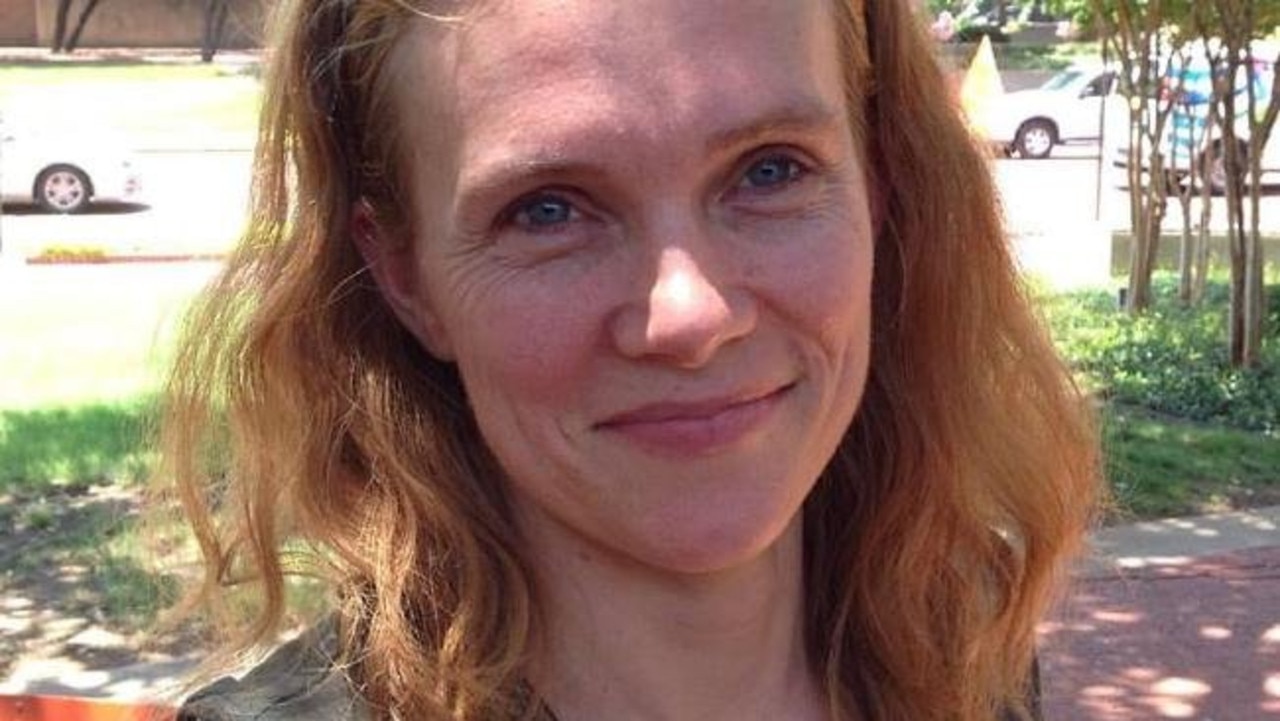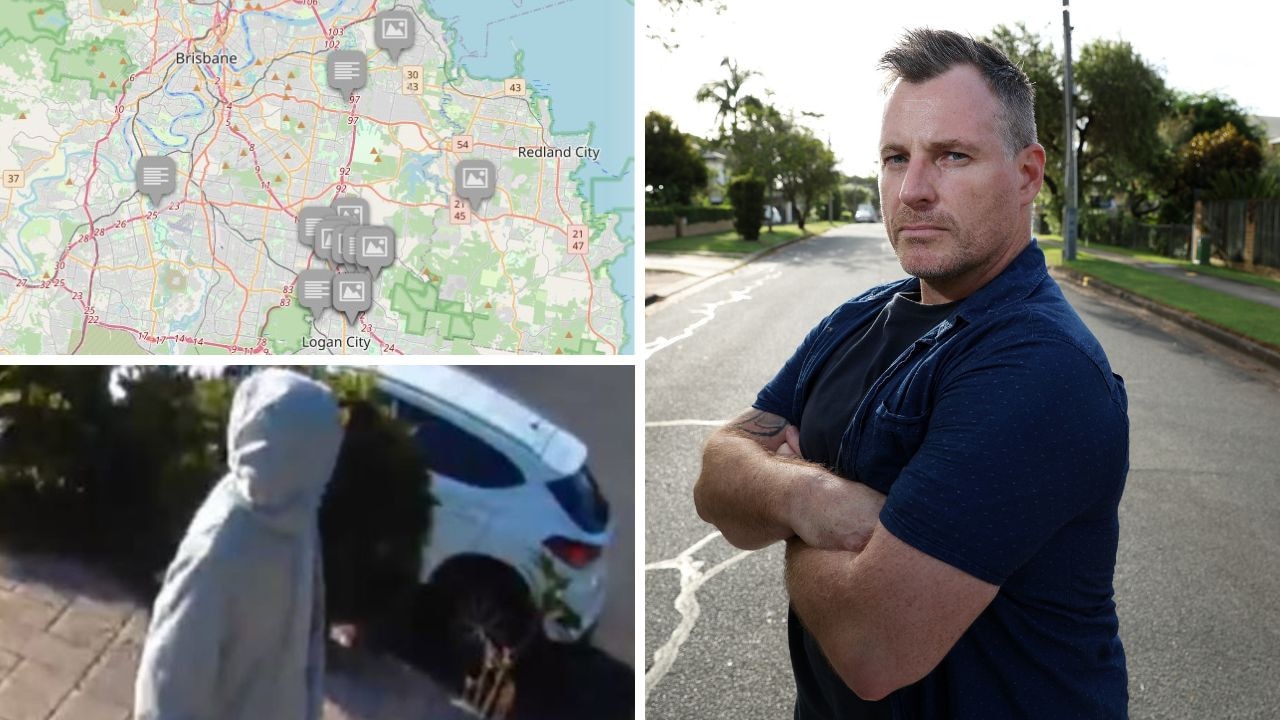Is Queensland Rail’s ‘new’ city service train timetable working?
THE Courier-Mail heads west on Queensland Rail’s Ipswich line and then jumps on the new service north to Redcliffe to check the wheels run smoothly, as is expected in a major capital city in the 21st century.
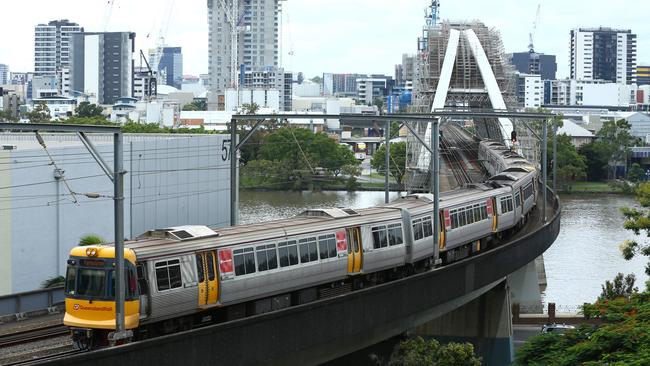
QLD News
Don't miss out on the headlines from QLD News. Followed categories will be added to My News.
WE’VE just hopped onto the train at Bowen Hills in Brisbane’s inner north and there they sit, commuters, dozens of them, with the public transport stare. You know the stare. That dull, half-blank, disinterested look that people in close proximity to strangers affect when they’re trying to make themselves invisible. A stare where the eyes are looking at something, in the distance, but at nothing, and everything; where the entire, painful focus of the public transport stare is not to make contact with another set of eyeballs.
On this day it’s warm outside the carriage – 30 degrees – and overcast. We’re on board the 9.53am all-stations train to Ipswich from platform three at Bowen Hills station and pass blooms of graffiti – “METH” – en route to our first stop, Fortitude Valley.
We’re here because it’s a fine Monday morning, and it also happens to be the first day of operation for Queensland Rail’s “new” city service train timetable following last year’s “rail fail”, the sudden and catastrophic implosion of southeast Queensland’s railway system following the historic opening of the new Redcliffe rail line, and the realisation that there actually weren’t enough train drivers to keep the system rolling. We’re here – along with construction workers, city desk jockeys, mothers, retirees, students, grandparents and that whole stew of different people that trains manage to throw together – to see if the wheels run smoothly, as you would expect of a suburban rail system in a major capital city in the 21st century.
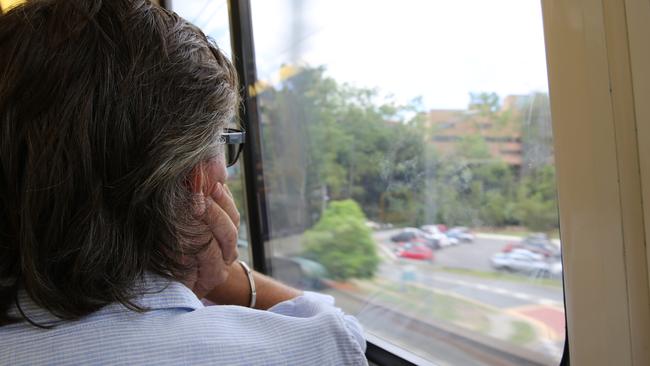
Or whether we’ll be returning to yesteryear, perhaps all the way back to the 1880s, when Brisbane’s branch lines started to push across the southeast Queensland landscape.
So far, so good. The carriage is airconditioned and comfortable, not overly crowded, and clean (despite a broken purple hair bauble on the floor, a handful of crushed cracker biscuits, and a disposable cup wedged beside a nearby seat).
“This is an Ipswich train, stopping at all stations,” says the automated station announcer in dulcet tones good enough for radio. “Doors closing, please stand clear … ”
As we pull out of Roma Street station for the journey west, there’s a large group of what appear to be Queensland Rail staff gathered on the platform. Most of them are brandishing oversized clipboards. The bulk of commuters have left the train, and it’s clear sailing all the way to Ipswich. Gazing out the window as we pause at the stations – Milton, Auchenflower, Toowong – you wonder, how will the timetable stand up? How did it get into such a mess in the first place? Will we make it to Ipswich?
It’s tempting to hum a children’s choo-choo nursery rhyme as the journey is, thus far, so pleasant. But it’s worth bearing in mind those lines from Nobel laureate Bob Dylan and his song It Takes a Lot to Laugh, It Takes a Train to Cry: “Don’t say I never warned you / when your train gets lost”.
Six years ago, a British documentary, Dispatches: Train Journeys from Hell, interviewed rail passengers about the most ridiculous public announcement excuses they’d heard for late trains. On the Cardiff to London line, delays were caused by “a giant clown on the line” (in fact an inflatable Ronald McDonald that had blown off the roof of its nearby restaurant). In other instances, rail authorities blamed tardy services on “slippery rain” and “dew” on the tracks. At Bournemouth station, passengers were told: “The train now arriving on platform one is on fire. Passengers are advised not to board this train.”
But what was the excuse when southeast Queensland’s busy rail network simply collapsed on Friday, October 21, when 167 services were suddenly cancelled?
In the fallout to that chaotic day, it would be revealed that the system had, for some time, been lurching towards its own failure. A combination of events would, in the end, expose the flaws in the glass: a growing transport network; internal ructions and secrecy within the corridors of the network provider; a slow drip of train drivers coming through their training courses; the opening of a brand-new branch line. And the sudden realisation that the extra workload would not only test, but break, the system.
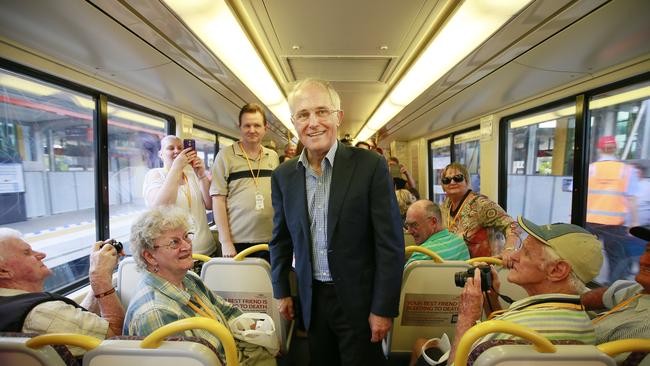
It was subsequently reported that a full 10 months prior to that Black Friday, management and business consultant Indec had provided Queensland Rail with a draft report expressing concern about driver shortages, particularly with regard to the impending Moreton Bay Rail Link (which would become known as the Redcliffe Peninsula Line). Two months later, Canadian-based public service experts GIRO similarly warned of insufficient driver and guard resources within the QR network. Still, the march towards the historic opening of the Redcliffe line continued apace until, on Monday, October 3, known train aficionado and Prime Minister, Malcolm Turnbull, was on hand to unveil the service, first publicly proposed in 1885.
Less than a fortnight later, the initial cracks began to appear. The media was reporting that QR was set to be fined for failing to run the Citytrain network on time, as per the quarterly performance targets in its service contract. The Courier-Mail wrote: “QR data shows that disruptions tied to the recent opening of the Redcliffe Peninsula Line has led to up to a third of trains running late. Flow-on problems have disrupted services on the Caboolture rail line, where up to a third of trains have run late each day this month. Trains have also been running late on the Sunshine Coast line … ”
This should have been a major blast of a train air horn in warning for QR, but nothing was done. Five days later, the network hit a sinkhole. “First of all I’m absolutely furious,” said Premier Annastacia Palaszczuk. “Let me make it clear. I want answers. And my minister wants answers.”
That minister was Transport Minister Stirling Hinchliffe. The Premier also wanted to know why – if the issue had been about a paucity of train drivers – hadn’t QR and its board notified Hinchliffe? “Surely someone in Queensland Rail knew that this was going to be a problem and failed to alert higher up the line,” she added.
The next day, QR chief executive Helen Gluer admitted that QR had failed in this instance and that communication around the issue was handled “very badly”. As for the root cause of the problem, Gluer said: “I can’t explain why we’ve got this wrong.” Within days Gluer and QR board chairman Michael Klug had resigned and train services delivery manager Mick Skinner was stood down. (Chief operations officer Kevin Wright would also later resign from his post in December.)
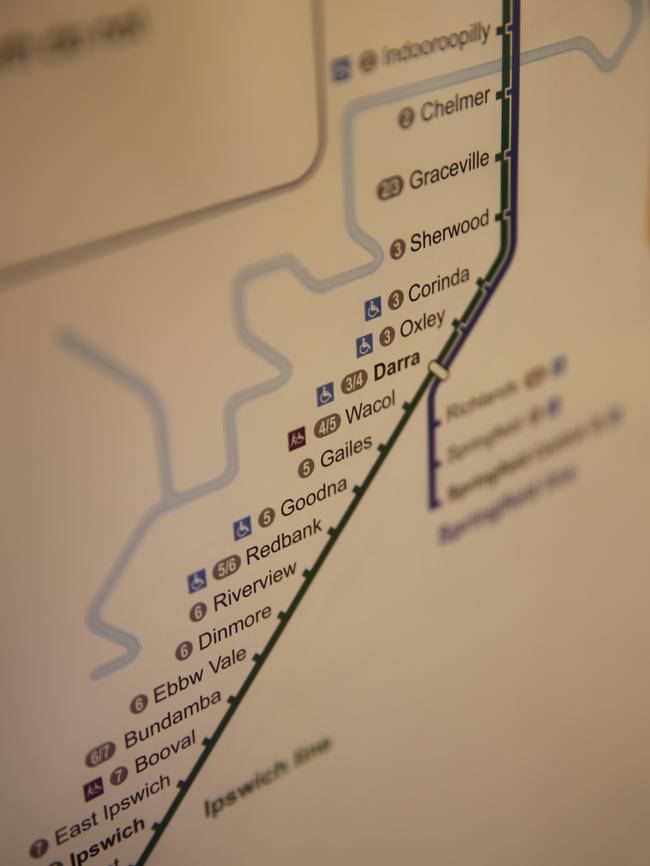
Scenting a ministerial scalp, Opposition Leader Tim Nicholls urged the Premier to ask Hinchliffe to resign over the debacle. “The minister is so out of touch with the thousands of Queenslanders left stranded on platforms that he’s still blaming everyone else for the stuff-up of stuff-ups,” Nicholls said. (Nicholls failed to mention that one possible contributing factor to the stuff-up, that being the axing of QR training staff under the LNP government and its one-term premier, Campbell Newman. Opposition Transport spokesman Andrew Powell refused to meaningfully comment on the allegation.)
Then began the great timetable shuffle in an attempt to stabilise the shaky network. Interim timetables popped up, and as the days and weeks unfolded, these too were tweaked and tinkered with.
Hinchliffe promised more train drivers and guards. Palaszczuk pledged an independent investigation. That was soon upgraded to the awkwardly titled Queensland Rail Train Crewing Practices Commission of Inquiry, with former Rio Tinto executive Phillip Strachan at its head.
With the powers of a commission of inquiry, Strachan could now get access to QR documentation, and indeed his investigative fingers could reach back into the defunct Newman government, if he so chose. (Strachan’s report is due to be released on February 6.)
Meanwhile, there were still trains to catch. The “old” timetable that was at the centre of the initial debacle in October was dumped for a “new”, more streamlined timetable in early November. This temporarily made way for the Christmas/New Year “holiday” timetable. And wouldn’t you know it? On Christmas Day itself, Queensland Rail’s gift to this seemingly never-ending drama was the cancellation of 235 out of 730 trains timetabled to operate on that day. The excuses offered by QR were that Christmas Day actually occurred on a Sunday and “many drivers had already worked the maximum of 18 Sundays for the year”, that annual leave and fatigue management combined left only about 20 per cent of QR’s driver pool available for work, as well as other rostering issues and an unanticipated spike in drivers calling in “sick” for the day.
At the last minute, Hinchliffe ordered that all rail travel on the network be free on Christmas Day. The holidays couldn’t have come sooner for the government, Hinchliffe and QR. But looming was the “new” timetable, actually the “old” post-November 7 timetable, effective January 23, 2017.
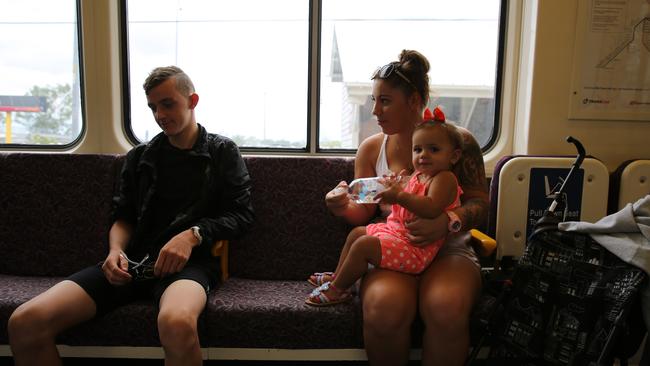
As we glide away from the Brisbane CBD, and through the suburban rings of the city – Taringa, Indooroopilly, Chelmer, Graceville, Sherwood – on the Ipswich Line, you realise one common factor about railway journeys.
In the CBD, the view from the carriage is invariably the forgotten, tatty, neglected, even raw side of the city – a vista of trash, pipes and building back entrances, garbage skips and abandoned chairs, and, as ever, that universal language that can rarely be deciphered – spraypainted graffiti. It’s our hidden and neglected face.
Then suddenly the landscape is all trees and gentrified Queenslanders. And later, it’s the Australian bush, and grazing horses and the occasional abandoned car.
Chantelle and Brent are riding in the Quiet Carriage (Please Refrain from Loud Conversations and Use of Loud Music and Mobile Devices). Chantelle is talking to Brent. Brent is studying his quiet mobile device. They sit opposite each other and have their feet up on the seats.
Chantelle says the system is running better than last year, when the trains to Ipswich were 45 minutes apart. “Now they all seem to connect,” she says happily. “It’s heaps better.”
“It beats driving a car, eh?” says Brent.
“We always get into trouble for having our feet on the seats,” Chantelle says, laughing. “Not from the train guys, but other passengers.”
They alight at Sherwood. “See ya,” Chantelle says, waving.
Corinda, Oxley. Gailes. Dinmore. Ebbw Vale. Ebbw Vale? (A suburb of Ipswich and named, we would discover later, after a town in Wales in the UK.)
We arrive on time at Ipswich, admire the large photographs of steam trains in the foyer of the station, and hop back onto another train bound for Brisbane city.
In one of the carriages we come across Lane and his friend Melissa and her little one-year-old Kyiesha. They’re from Ipswich, and they’re on their way to Darra station, where they’ll change for the train to Springfield. Their destination today is the Orion Lagoon and free waterpark.
“I head into the city at least three times a week,” Lane says. “Last year the timetable went to hourly (for the Ipswich train into the Brisbane CBD). Used to be half-hourly. It’s very painful. It should be half-hourly. They should fix everything up and stop being so wack about it.”
Melissa is indifferent. “I don’t really know much,” she says. “He tells me what times the trains are.”
Any particular reason they travel so much on weekdays back and forth to Brisbane?
“Ipswich is boring,” Melissa says.
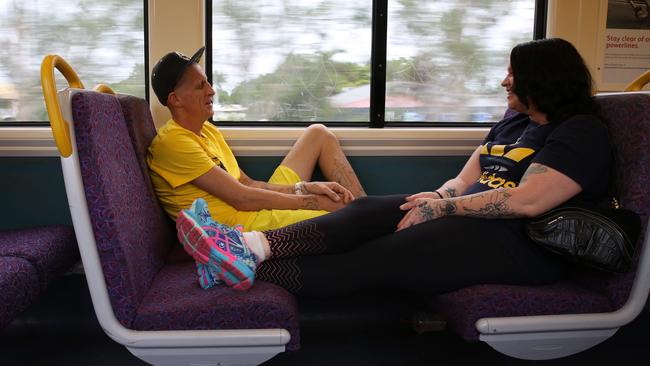
Further down the carriage, Ipswich resident Brian, a former QR employee, is late meeting friends for lunch in the city. He wasn’t aware the new timetable had come into effect on this morning. He wasn’t aware the service had shifted to hourly. (The Courier-Mail compared the “new” timetable with those in place going back to 1998 and found that, despite population growth and a greater demand for city rail services, 2017 timetable cuts of about 330 services had in some instances significantly “wound back the clock” on services.)
Now Brian is running late. “I worked in the workshops in Ipswich,” he says. “I’ve still got friends who are train drivers for QR. They tell me Campbell Newman stuffed the training process for new drivers and the problem started then. Everyone knew this was coming. It was an open secret.
“As they used to say, there’s the right way, the wrong way, and then there’s the railway. They’re trying to cope right across Queensland Railways. There simply aren’t enough drivers. Many have gone off to work in private enterprise. The new drivers will take time to come down the pipeline.
“I’ve been caught out today. But down the track you learn to live with it. But it was the Redcliffe line, wasn’t it? The perfect storm.”
It was time to meet the culprit – the six-stop Redcliffe Peninsula Line, the little artery that gave the Queensland Rail network a heart attack.
We’re back at Bowen Hills and according to the electronic timetable overhead, there’s an express train to Kippa-Ring, the end of the Redcliffe line, in just 16 minutes.
This new branch to the rail tree has, despite the October hiccup, fitted in seamlessly, or so it seems. Waiting for the train are retirees Phillip and his mate Rod. Incredibly, Phillip, from Ballarat in rural Victoria, has come all the way north to sample the Redcliffe line.
“I used to live up here, 10 or 15 years ago,” says Phillip. “I brought my family up here and worked for the Red Cross. That’s where I met Rod.
“I’m up here visiting him,” Phillip says of Rod, who was also once his co-worker at the Red Cross. Both men were disability support workers. “You know, when you get older, it’s always nice to visit someone before their funeral.”
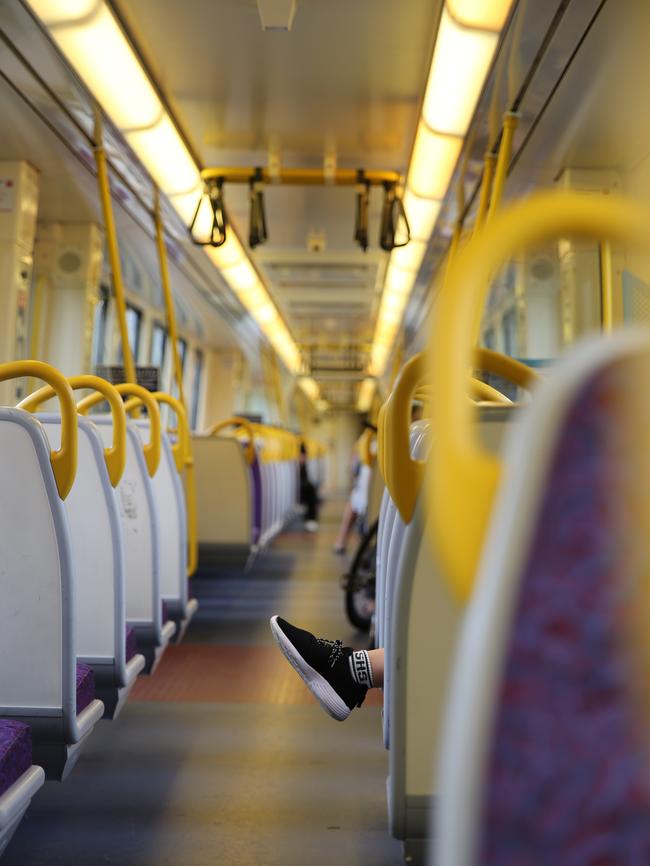
Phillip is looking forward to his “nostalgia” trip and revisiting the Redcliffe Peninsula, where he once lived before moving back down south. He’d heard about last year’s “rail fail”. But as Rod says, “I think if you ran the trains to people’s front doors they’d still find something to complain about.”
Milling about in QR uniforms, too, are two trainee driver instructors. Both, given the network’s current circumstances, are probably more than worth their weight in gold. “They’ve got a lot lined up for us, that’s for sure,” says one. “Yeah”, the other one says, “the training school is all backed up.”
Our northbound train arrives at 10.40am on this Friday, and we’re away. We’re express to Northgate, stopping only at Eagle Junction, then it’s on to Petrie and the turn northeast, on to the dastardly Redcliffe line.
Sitting opposite is Melissa from Kallangur. Her stop is first on the new line. “I remember last year,” she says of the chaos in late October. “We were forced to take buses and it was taking two hours to get home. Before the new line we used to have to get the bus to Petrie. But now it’s really good. We’re happy. It’s a three- to four-minute walk to the station. A lot of Kallangur people are very happy. We always used to travel by car, but not any more.”
There are car-wrecking yards out the window as we hurtle towards Carseldine. And a large billboard – “Jesus is the Christ, the Son of God. Read your Bible!”
Approaching the next stop, Bald Hills, there are fences and factory walls covered in the same graffiti, the simple but mind-numbingly repetitive “ACEACEACEACEACEACEACE”. Getting closer to Strathpine, we break into open fields and grazing cattle. Then once through Petrie, we find ourselves on it, the troublemaker, the Redcliffe Peninsula Line.
Melissa and her children hop off at the first stop, Kallangur. There are shiny new seats at the station, and shiny new rubbish bins. The commuter carparks are close to full. There is no graffiti. Yet.
We wonder if we’re on the right train, and haven’t gotten on a rattler to Charleville, when a passenger steps off at Rothwell wearing a tall black cowboy hat.
We slow down to our destination, Kippa-Ring, quite literally the end of the line. The ride has been so comfortable, so effortless, so trouble-free, that a man with a bluebird tattooed on his neck has fallen asleep in his seat. Even his partner flicking him around the head with a rolled up paper barely rouses him.
But we’re here. “Bye bye train,” a little boy says as he walks along the platform.
We catch up with Phillip and Rod. A very agreeable journey, they conclude. They’ll now catch the bus down to Redcliffe proper. Phillip gives the new line the thumbs-up. “It’s something they (the people served by the Redcliffe line) have never had before,” he says.
A staff member at the Kippa-Ring station says the crowds on the train during the day were exceeding the peak-hour periods. “The locals absolutely love it. House prices have gone up. It’s been a really great exercise,” he says. “People love it.”
At 11.45am, we’re back on the express to Brisbane city. The whistle blows, the train issues a ding ding, and the doors hiss closed. “Oi,” one passenger who looks a little worse for wear says to two young girls sitting across from him. “If I pass out, can you wake me up at Northgate? Just been on a fishing trip for two days. You’ll wake me up, woncha?”
A large family sits not far away. One of the boys takes a selfie of himself and belches. His brother has the hiccups.
Two English tourists fresh off the plane are heading into the city, wide-eyed.
“Look, Mummy, cows!” a child shouts.
There goes ACEACEACEACEACEACE.
And the man announcing the upcoming stations sounds like he’s auditioning for a part in the musical Starlight Express by Andrew Lloyd Webber. “Zillllllllllllmere-ah!” he says theatrically.
Life, like trains, rolls on.
(Seventy-two hours after The Courier-Mail travelled the Redcliffe Peninsula Line it was shut down due to a “telemetry fault”, according to TransLink, leading to morning peak-hour chaos. The TransLink website reported that all southeast Queensland lines were running normally. The Redcliffe line weblink, however, featured next to it a yellow triangle containing an exclamation mark. The issue was described as “minor”.) ■

